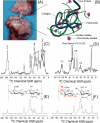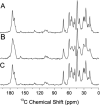Solid-state NMR spectroscopy provides atomic-level insights into the dehydration of cartilage
- PMID: 21786810
- PMCID: PMC3158280
- DOI: 10.1021/jp205663z
Solid-state NMR spectroscopy provides atomic-level insights into the dehydration of cartilage
Abstract
An atomic-level insight into the functioning of articular cartilage would be useful to develop prevention strategies and therapies for joint diseases such as osteoarthritis. However, the composition and structure of cartilage and their relationship to its unique mechanical properties are quite complex and pose tremendous challenges to most biophysical techniques. In this study, we present an investigation of the structure and dynamics of polymeric molecules of articular cartilage using time-resolved solid-state NMR spectroscopy during dehydration. Full-thickness cartilage explants were used in magic-angle spinning experiments to monitor the structural changes of rigid and mobile carbons. Our results reveal that the dehydration reduced the mobility of collagen amino acid residues and carbon sugar ring structures in glycosaminoglycans but had no effect on the trans-Xaa-Pro conformation. Equally interestingly, our results demonstrate that the dehydration effects are reversible, and the molecular structure and mobility are restored upon rehydration.
© 2011 American Chemical Society
Figures






Similar articles
-
Time-resolved dehydration-induced structural changes in an intact bovine cortical bone revealed by solid-state NMR spectroscopy.J Am Chem Soc. 2009 Dec 2;131(47):17064-5. doi: 10.1021/ja9081028. J Am Chem Soc. 2009. PMID: 19894735 Free PMC article.
-
Collagen dynamics in articular cartilage under osmotic pressure.NMR Biomed. 2006 Dec;19(8):1010-9. doi: 10.1002/nbm.1061. NMR Biomed. 2006. PMID: 16823903
-
Comparison of collagen dynamics in articular cartilage and isolated fibrils by solid-state NMR spectroscopy.Magn Reson Med. 2002 Oct;48(4):624-32. doi: 10.1002/mrm.10272. Magn Reson Med. 2002. PMID: 12353279
-
Composition and dynamics of articular cartilage: structure, function, and maintaining healthy state.J Orthop Sports Phys Ther. 1998 Oct;28(4):203-15. doi: 10.2519/jospt.1998.28.4.203. J Orthop Sports Phys Ther. 1998. PMID: 9785256 Review.
-
Magic-angle effect in magnetic resonance imaging of articular cartilage: a review.Invest Radiol. 2000 Oct;35(10):602-21. doi: 10.1097/00004424-200010000-00007. Invest Radiol. 2000. PMID: 11041155 Review.
Cited by
-
Design Parameters of Tissue-Engineering Scaffolds at the Atomic Scale.Angew Chem Int Ed Engl. 2019 Nov 18;58(47):16943-16951. doi: 10.1002/anie.201907880. Epub 2019 Oct 30. Angew Chem Int Ed Engl. 2019. PMID: 31573131 Free PMC article.
-
Unveiling Charge-Pair Salt-Bridge Interaction Between GAGs and Collagen Protein in Cartilage: Atomic Evidence from DNP-Enhanced ssNMR at Natural Isotopic Abundance.J Am Chem Soc. 2024 Aug 28;146(34):23663-23668. doi: 10.1021/jacs.4c05539. Epub 2024 Jul 9. J Am Chem Soc. 2024. PMID: 38980938 Free PMC article.
-
Fourier Transform Infrared Microspectroscopy Combined with Principal Component Analysis and Artificial Neural Networks for the Study of the Effect of β-Hydroxy-β-Methylbutyrate (HMB) Supplementation on Articular Cartilage.Int J Mol Sci. 2021 Aug 25;22(17):9189. doi: 10.3390/ijms22179189. Int J Mol Sci. 2021. PMID: 34502096 Free PMC article.
-
Molecular Mobility in Keratin-Rich Materials Monitored by Nuclear Magnetic Resonance: A Tool for the Evaluation of Structure-Giving Properties.Biomacromolecules. 2023 Jun 12;24(6):2661-2673. doi: 10.1021/acs.biomac.3c00131. Epub 2023 May 18. Biomacromolecules. 2023. PMID: 37199647 Free PMC article.
-
A serial multiparametric quantitative magnetic resonance imaging study to assess proteoglycan depletion of human articular cartilage and its effects on functionality.Sci Rep. 2020 Sep 15;10(1):15106. doi: 10.1038/s41598-020-72208-y. Sci Rep. 2020. PMID: 32934341 Free PMC article.
References
-
- Cohen NP, Foster RJ, Mow VC. J. Orthop. Sports Phys. Ther. 1998;28:203–15. - PubMed
-
- Kirk TB, Wilson AS, Stachowiak GW. J. Orthop. Rheumatol. 1993;6:21–28.
-
- Naji L, Kaufmann J, Huster D, Schiller J, Arnold K. Carbohydr. Res. 2000;327:439–46. - PubMed
-
- Huster D, Schiller J, Arnold K. Magn. Reson. Med. 2002;48:624–32. - PubMed
Publication types
MeSH terms
Substances
Grants and funding
LinkOut - more resources
Full Text Sources

